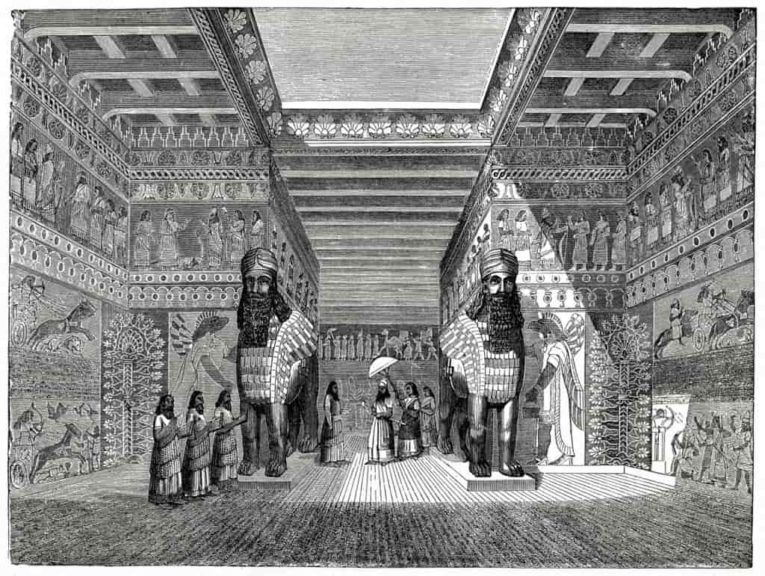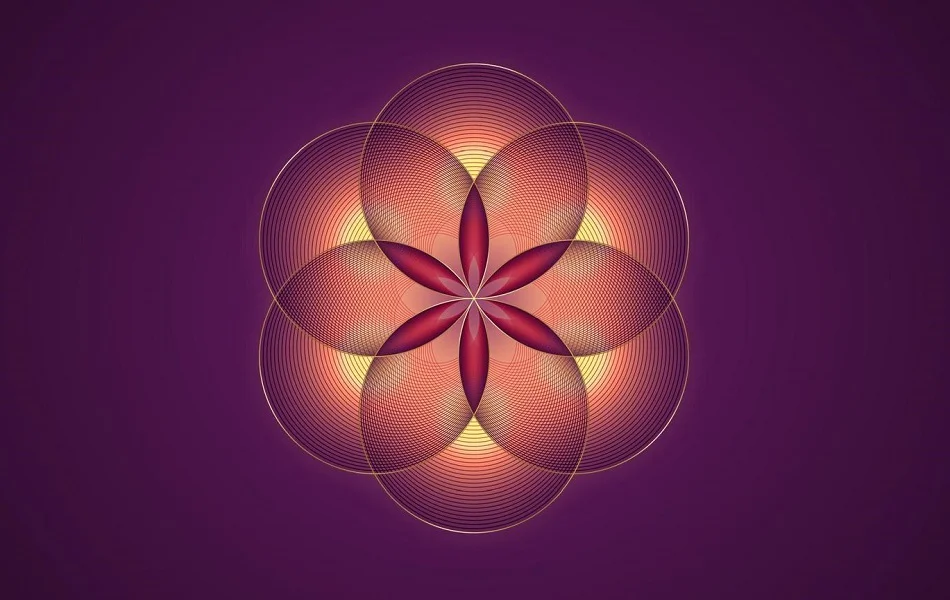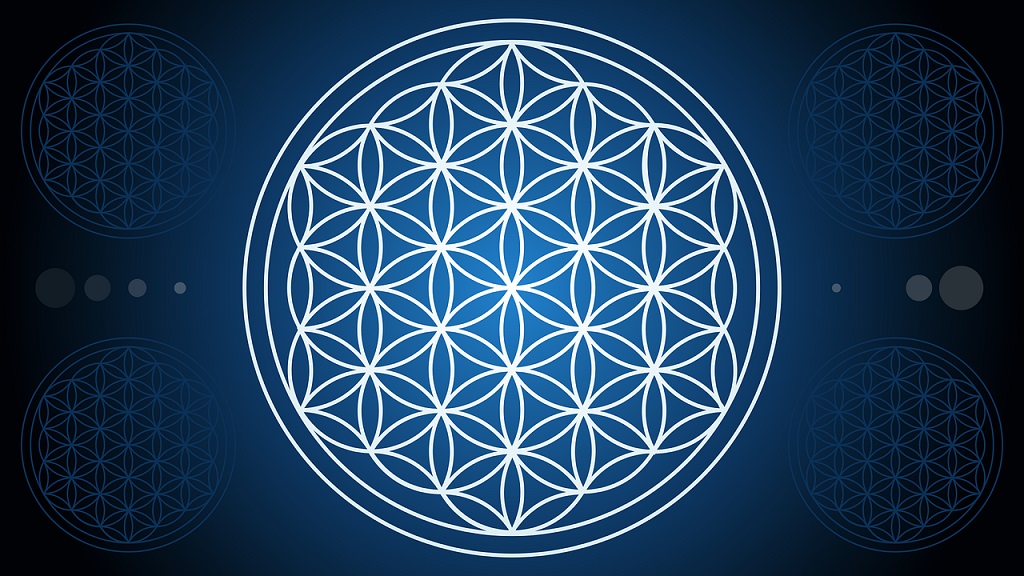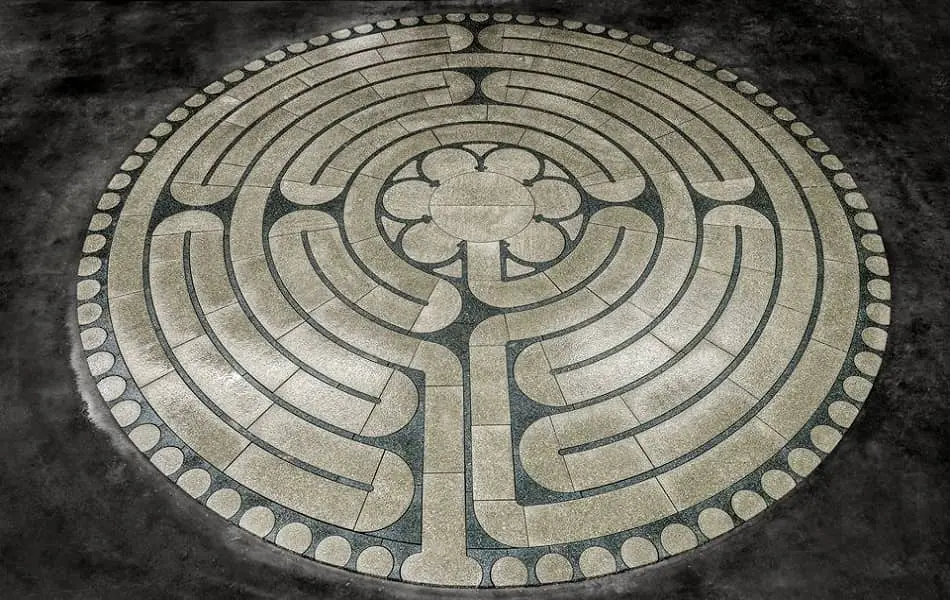Can Sacred Geometry Produce Musical Harmony?

Geometric Frequencies
Is there a direct correlation between geometry and frequency? Were ancient civilizations given a key to connect mathematics, geometry, and sound?
Eric Rankin believes so in his documentary revolving around an interconnectedness between geometry and frequency. Sonic Geometry focuses on harmony found when the sum of the angles of all shapes is played as frequencies.
The basis of Rankin’s theory dates to the ancient Sumerian culture, roughly 5,000 years ago. The Sumerian civilization in Mesopotamia oft referred to as the Cradle of Civilization, spawned the first written language and mathematical system. The Ancient Sumerians wrote that the information that is the basis for their systems came from ‘sky gods,’ known as the Annunaki. They relied on a system of mathematics based on the numbers 12 and 60. We still retain some of the Sumerian’s mathematical system in how we calculate time, measurement in inches, and in geometry.

Pythagorean Tuning
We’re all familiar with the Pythagorean theorem in geometry, but the Greek philosopher/mathematician is not as commonly known to have applied his focus to music. Pythagoras applied geometry to music when he noticed how dividing a string in half would double its pitch. He created the Pythagorean scale based on harmonic fifths, which is now used as a root in modern music.
But according to Rankin, Pythagoras’ scale led him to stumble upon the number 432, maybe without knowing its synchronistic implications. The number happens to appear on his scale of fifths, which became the keystone for tuning frequency until the 20th century.
The sum of the angles of the basic geometric shapes, when played as frequencies, increases in octaves as you add additional sides. When combining these frequencies starting with a triangle, all the way up to an octagon, they create perfect harmony in a three-part major chord of F#. This pattern works with three-dimensional shapes as well as sacred geometric patterns to create harmonies.
The Mayan Equinox
The Ancient Mayan civilization was astronomically in tune and knew about the Earth’s axial precession. The Mayans calculated the time it took for a complete rotation of the Earth’s wobble on its axis to be 25,920 years, with one month being 2160 years. It happens that the diameter of the moon is 2160 miles. When this number is divided simply, you get some interesting results…
2160/2 = 1080 – the angle sum of an octagon
2160/3 = 720 – the angle sum of a hexagon
2160/4 = 540 – the angle sum of a pentagon
2160/5 = 432 – the Pythagorean frequency key tone
2160/6 = 360 – the angle sum of a circle and square
Rankin presents evidence of the recurrence of the number 432 as being found in multiples of measurement of time and distance, from the moon and sun to the speed of light. He believes there is some connection that is hidden within this number, that could have possibly been gifted to the Ancient Sumerians by the Annunaki and has remained embedded in many aspects of how we measure our world.
A Change in Frequency
In the early 1900s, there was a shift away from the 432hz frequency to 440hz. Almost all music since then has been recorded in this frequency, which does not have the same numerical synchronicity. To those who have alternated between the two frequencies, there is a noticeable difference.
Some theorize that the frequencies were changed as a sinister plot by the Nazis as a way of subversively increasing aggression or agitation on a large scale. It has been shown that different sound frequencies affect everything from water molecules to living organisms at different levels, so a plot to change the frequency of music sent to the masses seems like a plausible tactic of disruption. However one must judge for themselves — is the difference in frequencies big enough to manipulate human consciousness?
Cosmic Cycles of 432
Joseph Campbell found the number 432 intriguing in his studies, particularly as it recurred across different religious contexts. One instance is of an ancient Babylonian priest who wrote an account of the history of Babylonia in which a flood destroyed everything after 432,000 years.
In the ancient Hindu timeline, cosmic cycles are measured in multiples of 432,000 years. The Kali Yuga is 432,000 years, followed by the Dwapara Yuga at 864,000 years, the Treta Yuga at 1,296,000 years and lastly the Satya Yuga at 1,728,000 years.
There is even reference to cosmic cycles of 432,000 in the Icelandic Eddas, recounting Norse mythology. In one book describing Odin’s hall in Valhalla, there are 540 doors with 800 warriors coming through each door representing our time cycle. Those numbers multiplied, of course, equal 432,000.
With the interrelation of mathematics and nature as seen in such instances as the Fibonacci Sequence, it would come as no surprise that there would be an intrinsic relationship between geometry and sound frequency. What other inherent connections have we yet to discover in the nature of our existence?

7 Sacred Geometry Symbols and Their Meanings

Sacred geometry is a discipline that studies the geometric shapes and patterns found in nature and in human-made structures. These figures are considered sacred due to their perfect symmetry and proportions, which are believed to reflect the harmony of the universe. In this article, we explore the meanings of seven sacred geometry symbols and how they can influence our spiritual and daily lives.
Table of Contents
- What is Sacred Geometry and What is its Purpose?
- 7 Sacred Geometry Symbols and Their Meanings
- History and Origin of Sacred Geometry
- How to Integrate Sacred Geometry into Daily Life
What is Sacred Geometry and What is its Purpose?
Sacred geometry is the study of geometric shapes that appear in nature and human constructions, considered sacred due to their perfect symmetry and proportions. These shapes include structures such as the cube, tetrahedron, and dodecahedron, among others. It is believed that sacred geometry connects with the order and harmony of the universe, providing a deeper understanding of the structure of reality.
These geometric figures are found in a variety of contexts, from ancient architecture to modern art. Temples and cathedrals often incorporate sacred geometry patterns in their design, using these shapes to create spaces that promote meditation and spiritual connection. Additionally, these figures are also found in nature, such as in the structure of crystals and the shapes of plants and animals.
Sacred geometry is also applied in meditation and spiritual practices. By meditating on these figures, one can harmonize internal energies with universal energies, promoting healing and spiritual growth. Geometric shapes act as a bridge between the physical and the spiritual, facilitating a deeper connection with the cosmos.
In the series Sacred Geometry: Spiritual Science, available on Gaia, it is explored how these geometric shapes are essential for understanding the structure of the universe and how they can be used in spiritual and meditative practices to enhance awareness and spiritual connection.
7 Sacred Geometry Symbols and Their Meanings
There are several sacred geometry symbols that are widely known and used in various spiritual traditions. These symbols include the Metatron’s Cube, the Merkaba, the Seed of Life, the Flower of Life, the Sri Yantra, the Torus Yantra, and the Celtic Labyrinth. Each of these symbols has a profound meaning and is used for different purposes in meditation and spiritual practices.
Metatron’s Cube

Metatron's Cube is a sacred geometry figure that contains the five Platonic solids: tetrahedron, hexahedron, octahedron, dodecahedron, and icosahedron. These solids are arranged in such a way that they represent the fundamental structure of the universe. The cube is used in spiritual and meditative practices to connect with universal energy, providing balance and harmony to the user. Additionally, it is considered a powerful tool for protection and energy cleansing.
This symbol is not only visually impressive but also holds deep spiritual meanings. It is believed that Metatron’s Cube acts as a bridge between the material and spiritual worlds, allowing practitioners to access higher dimensions and sacred knowledge. Meditating with Metatron’s Cube can help align internal energies with cosmic forces, promoting healing and spiritual growth.
The Merkaba

The Merkaba is a geometric figure formed by two interlocking tetrahedrons that rotate in opposite directions, creating a three-dimensional star. This symbol represents the union of spirit and body and is used to facilitate spiritual ascension and the expansion of consciousness. By activating the Merkaba, one can balance and harmonize the body’s energies, facilitating connection with higher dimensions and access to elevated states of consciousness.
In spiritual practices, the Merkaba is known for its ability to protect and heal. Meditating with the Merkaba can help activate the energy field around the body, known as the Merkaba field, which acts as a protective shield against negative energies. Additionally, this energy field is believed to facilitate astral travel and mystical experiences, providing a powerful tool for spiritual exploration and personal development.
The Seed of Life

The Seed of Life is a sacred geometry symbol composed of seven interlocking circles that form a flower-like pattern. It represents the seven days of creation and is considered a symbol of fertility and creation. This basic pattern is the foundation of more complex figures like the Flower of Life and is used in meditation to promote healing and spiritual growth.
The spiritual meaning of the Seed of Life lies in its representation of the interconnectedness of all life in the universe. Meditating with this symbol can help connect with the energy of creation and foster a sense of unity and harmony. The Seed of Life is used in various spiritual practices to stimulate creativity, fertility, and the manifestation of new beginnings.
The Flower of Life

The Flower of Life is an expansion of the Seed of Life and is composed of multiple interlocking circles that create a more complex pattern. This symbol is considered one of the most sacred patterns and is believed to contain the secrets of the universe, including the shapes of the Platonic solids. The Flower of Life represents the interconnectedness of all life and is used to meditate on unity and harmony.
This symbol is not only visually appealing but also holds deep spiritual meanings. The Flower of Life is considered a visual representation of the life force energy that flows through all living things. Meditating with the Flower of Life can help activate this life force energy, promoting healing and spiritual growth. This symbol is also used to connect with universal energies and to explore the mysteries of creation.
The Sri Yantra

The Sri Yantra is a Hindu symbol composed of nine interlocking triangles that form 43 smaller triangles, all enclosed within an eight-petaled lotus. This complex geometric design represents the cosmos and the structure of the universe, symbolizing the union of the masculine and feminine. It is used in meditation and rituals to promote prosperity, peace, and harmony. The Sri Yantra is considered a powerful tool for manifesting desires and connecting with divine energy.
Meditating with the Sri Yantra helps align internal energies with cosmic forces, promoting healing and spiritual growth. This symbol is also used to balance the chakras and improve concentration and mental clarity. The intricate structure of the Sri Yantra acts as a map of the spiritual journey, guiding the practitioner toward a greater understanding and realization of their connection with the universe.
The Torus Yantra or Toroid

The Torus Yantra, or Toroid, is a geometric shape that represents a ring-shaped energy field, similar to a donut. This symbol reflects infinite energy and continuous creation, symbolizing the flow and balance of energies in the universe. The toroid is considered a model of the universe’s structure and is used in meditation to harmonize internal and external energies, facilitating a state of balance and well-being.
Meditating with the Torus Yantra helps activate the flow of energy in the body, promoting healing and spiritual growth. This symbol is also used to connect with universal energies, facilitating the expansion of consciousness and the integration of cosmic energies into daily life. The toroid is a visual representation of the human energy field, providing a powerful tool for transformation and spiritual elevation.
The Celtic Labyrinth

The Celtic Labyrinth is a pattern of interlocking paths used in meditation and spiritual rituals. This symbol represents the journey of life and the search for the center, symbolizing introspection and personal transformation. Walking a Celtic labyrinth is considered a meditative practice that can help calm the mind and find spiritual clarity. Celtic labyrinths are used to foster inner peace and connection with the self.
The spiritual meaning of the Celtic Labyrinth lies in its representation of the path to enlightenment. By walking the labyrinth, one embarks on a metaphorical journey toward self-knowledge and spiritual understanding. This practice helps release tensions and worries, allowing for a deeper connection with one’s spiritual center and facilitating introspection and emotional healing.
History and Origin of Sacred Geometry
Sacred geometry has its roots in ancient civilizations, where geometric patterns observed in nature were replicated. The Egyptians, for example, used geometry in the construction of the pyramids, believing that these shapes contained mystical and energetic properties. Egyptian structures were designed to align with cardinal points and certain astronomical events, reflecting a deep connection with the cosmos.
In ancient Greece, sacred geometry was formalized and deeply studied by philosophers and mathematicians such as Pythagoras and Plato. Pythagoras observed that certain geometric patterns and proportions repeated in nature and developed the concept of the Platonic solids, geometric shapes that represent the building blocks of the universe. Plato, in his work “Timaeus,” linked these solids to the fundamental elements of creation: earth, water, air, fire, and ether.
The cultures of India and China also incorporated sacred geometry into their spiritual and architectural practices. The mandala and yantra are examples of geometric symbols used in meditation and temple construction, aiming to facilitate connection with the divine and promote spiritual harmony. These patterns reflect the belief in an interconnected universe, where geometry is the foundation of all things.
During the Renaissance, interest in sacred geometry resurfaced in Europe, driven by artists and scientists such as Leonardo da Vinci and Johannes Kepler. Da Vinci studied and used the golden ratio in his art, while Kepler explored the relationship between the Platonic solids and planetary orbits. This period marked a fusion of art, science, and spirituality, highlighting the importance of sacred geometry in understanding the universe and human experience.
How to Integrate Sacred Geometry into Daily Life
Integrating sacred geometry into daily life can bring balance, harmony, and a deeper spiritual connection. Here are some practical ways to do so:
- Meditation with symbols: Use figures like Metatron’s Cube or the Flower of Life during your meditations. These shapes can help focus your mind and harmonize your internal energies.
- Home decoration: Incorporate sacred geometry patterns into your home decor. Placing paintings or objects with these symbols can create an atmosphere of peace and balance.
- Yoga and energy exercises: Use postures and movements inspired by geometric shapes during your yoga practice. This can help align your body and mind with universal energies.
Art and creativity: Create your own designs based on sacred geometry. Drawing and painting these patterns can be a meditative and creative way to connect with the divine.




































